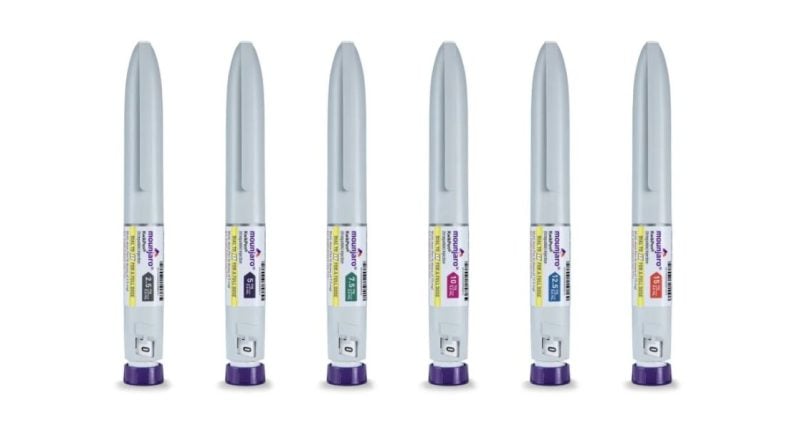Mounjaro is a weight loss injection that targets the core issues of type 2 diabetes and obesity through its dual action as both a GLP-1 (Glucagon-like peptide-1) and GIP (Glucose-dependent insulinotropic polypeptide) agonist.
Hailed as the “King Kong” of weight loss injections, Mounjaro is unique in that the medication activates the receptors for these GLP-1 and GIP hormones in the body, enhancing insulin production, improving insulin sensitivity, and moderating blood sugar levels.
What is Mounjaro?
Mounjaro is an effective weight loss treatment shown in clinical trials to help people achieve significant weight loss.
Known in the US as Zepbound, it is the latest weight loss injection available in the UK.
Mounjaro contains the active compound tirzepatide, and is a trademark of Eli Lilly.
- Research shows Mounjaro achieves better weight loss results than Wegovy and Ozempic
- Mounjaro: new weight loss jab approved in the UK
- Warning that Ozempic and Mounjaro can trigger accelerated aging
How does Mounjaro work?
Mounjaro contains the active ingredient tirzepatide, a type of GLP-1 agonist.
GLP-1 agonists help regulate blood sugar post-meal by stimulating insulin secretion, suppressing glucagon secretion, and slowing gastric emptying.
GIP agonists complement this by not only boosting insulin secretion but also enhancing the body’s insulin sensitivity.
This approach addresses the underlying symptom of insulin resistance in type 2 diabetes, setting Mounjaro apart from other treatments like Semaglutide and liraglutide, which lack the additional benefit of GIP activation.
How does Mounjaro support weight loss?
Mounjaro supports weight loss through:
Reducing appetite
Mounjaro delays gastric emptying which promotes a sense of fullness, reduces appetite and naturally reduces calorie intake, and helps to regulate blood sugar levels by slowing down the absorption of glucose from food.
Increasing energy expenditure
Mounjaro activates receptors that boost metabolic rate and energy use, aiding in calorie burning.
Improving insulin sensitivity
The modulation of GIP receptors enhances glucose utilisation, contributing to sustained satiety and weight maintenance.
How effective is Mounjaro?
Clinical studies highlight Mounjaro’s effectiveness in weight reduction, showing participants losing up to 20% of their body weight over 72 weeks, particularly at higher doses.
These results underscore Mounjaro’s role as a potent option for weight loss, especially when coupled with lifestyle modifications.
Taking Mounjaro
Before initiating Mounjaro, patients should receive proper usage training from healthcare providers, discuss low blood sugar management, and consider alternative birth control methods due to potential interactions.
Regular monitoring and healthcare provider consultations are essential to optimise treatment outcomes and address any concerns.
Dosages
The recommended starting dosage of Mounjaro is 2.5mg injected once a week under the skin. This dosage is for treatment initiation and not intended for glycemic control.
After 4 weeks, the dosage is increased to 5mg injected once-a-week.
Some people achieve significant weight loss with low doses of Mounjaro (2.5mg-5mg), while others require higher doses (12.5mg-15mg) to see meaningful results.
Onset of action
Mounjaro begins to impact blood sugar levels immediately upon administration.
Achieving a healthy HbA1c level can take up to 12 weeks, with variations depending on individual health conditions and adherence to the prescribed regimen.
For weight loss, significant results are typically observed around the 28-week mark, emphasising the importance of a balanced diet and exercise in conjunction with Mounjaro therapy.
- FDA approves new obesity drug Zepbound to compete with Wegovy
- Weight loss drug may benefit hip replacement patients
- Prue Leith: Obesity rates could fall if schools teach students how to cook healthy meals
What’s the difference betwen Mounjaro and Wegovy?
Mounjaro (tirzepatide) and Wegovy (semaglutide) are two medications used in the treatment of type 2 diabetes and for weight loss in individuals with obesity or overweight conditions.
However, both medications have distinct mechanisms and characteristics.
Wegovy (semaglutide) functions primarily as a GLP-1 receptor agonist that increases insulin production, decreases glucagon secretion, and slows down gastric emptying.
In clinical studies, semaglutide has demonstrated substantial weight loss outcomes with patients experiencing an average weight loss of around 15-18% of their body weight over 68 weeks.
Mounjaro (tirzepatide), on the other hand, is unique as it acts as both a GLP-1 and GIP receptor agonist enhancing the body’s insulin production in response to meals, improves insulin sensitivity and slows gastric emptying.
Clinical trials have shown that tirzepatide can lead to significant weight loss with patients potentially losing up to 20% of their body weight.
Both medications are administered through subcutaneous injections.
Mounjaro is typically injected once a week, and Wegovy is also a once-weekly injection.
Mounjaro side effects
Mounjaro’s use is accompanied by critical side effect warnings, including potential risks for:
- Thyroid tumours
- Pancreatitis
- Hypoglycemia
- Severe allergic reactions
- Kidney failure
- Gallbladder problems
Mounjarois not suitable for individuals with a history of medullary thyroid carcinoma (MTC), Multiple Endocrine Neoplasia syndrome type 2 (MEN 2), or those allergic to its ingredients.
Common side effects
Mounjaro can cause side effects such as:
- Nausea
- Diarrhoea
- Decreased appetite
- Abdominal pain
Monitor and report any adverse effects to your healthcare provider is crucial for managing and adjusting treatment as necessary.
Summary
- Price: From £179 per month
- Function: Appetite suppression
- Effectiveness: Average loss of 15-20% body weight
- Common side effects: Fatigue, dizziness, insomnia, gastrointestinal discomfort
- Dosage: Begins at 2.5mg weekly, with possible titration to 15mg






